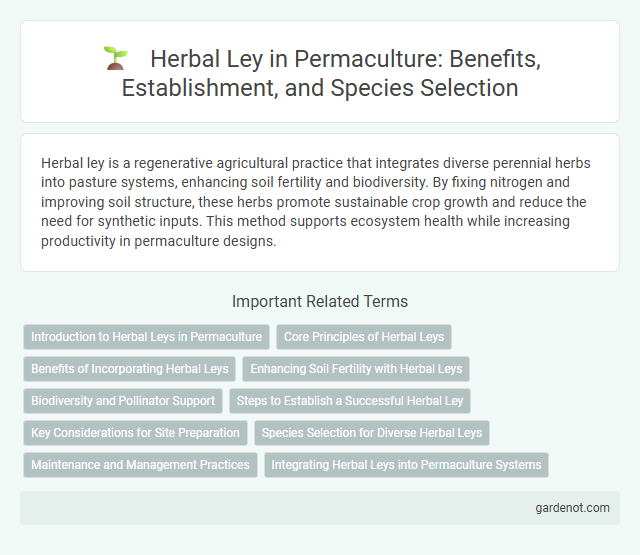Herbal ley is a regenerative agricultural practice that integrates diverse perennial herbs into pasture systems, enhancing soil fertility and biodiversity. By fixing nitrogen and improving soil structure, these herbs promote sustainable crop growth and reduce the need for synthetic inputs. This method supports ecosystem health while increasing productivity in permaculture designs.
Introduction to Herbal Leys in Permaculture
Herbal leys in permaculture involve planting diverse mixtures of herbs and legumes to improve soil fertility, enhance biodiversity, and support beneficial insects. These plant combinations fix nitrogen naturally, increase organic matter, and suppress weeds, boosting overall ecosystem health. Incorporating herbal leys into crop rotations promotes sustainable land management and long-term soil resilience.
Core Principles of Herbal Leys
Herbal leys integrate diverse, deep-rooted herbaceous species with nitrogen-fixing plants to improve soil fertility, structure, and biodiversity. They promote nutrient cycling by combining species with complementary rooting depths and growth habits, enhancing soil organic matter and microbial activity. Core principles include temporal diversity through rotational grazing or mowing, species selection for multifunctionality, and maintaining continuous plant cover to prevent erosion and suppress weeds.
Benefits of Incorporating Herbal Leys
Incorporating herbal leys into permaculture systems enhances soil fertility by fixing nitrogen and improving organic matter content, which supports healthier plant growth. These diverse plant mixtures increase biodiversity, attracting beneficial insects and pollinators that help control pests naturally. Herbal leys also improve soil structure and moisture retention, leading to greater resilience against erosion and drought conditions.
Enhancing Soil Fertility with Herbal Leys
Herbal leys improve soil fertility by introducing diverse deep-rooted plants that fix nitrogen, mobilize nutrients, and increase organic matter. The complex root systems enhance soil structure, promote microbial diversity, and support beneficial insects, leading to healthier soil ecosystems. Regularly rotating herbal leys in permaculture systems builds resilient, nutrient-rich soils essential for sustainable crop production.
Biodiversity and Pollinator Support
Herbal ley enhances biodiversity by integrating diverse herbaceous plant species that create a complex ecosystem supporting various insects, birds, and soil organisms. This polyculture provides continuous flowering, essential for nurturing pollinators such as bees, butterflies, and hoverflies throughout different seasons. The improved habitat not only boosts pollination efficiency but also strengthens ecosystem resilience in permaculture systems.
Steps to Establish a Successful Herbal Ley
Selecting diverse medicinal and nitrogen-fixing plants is essential for a productive herbal ley, enhancing soil fertility and pest resistance. Preparing well-drained, nutrient-rich soil through deep cultivation and organic amendments ensures optimal root development. Regularly managing the ley by mowing, rotational grazing, and reseeding maintains plant health and maximizes biodiversity for sustainable yields.
Key Considerations for Site Preparation
Herbal ley establishment requires careful site preparation including soil testing to analyze pH levels, organic matter, and nutrient availability for optimal herb growth. Removing existing vegetation and minimizing soil disturbance help create a suitable seedbed, while incorporating organic amendments like compost enhances soil structure and fertility. Selecting appropriate herb species based on climate, soil type, and intended ecosystem services ensures long-term productivity and biodiversity in the permaculture system.
Species Selection for Diverse Herbal Leys
Selecting a diverse range of perennial herbs such as chicory (Cichorium intybus), yarrow (Achillea millefolium), and plantain (Plantago lanceolata) enhances soil fertility and promotes beneficial insect habitats in herbal leys. Balancing nitrogen-fixing legumes like clover (Trifolium spp.) with deep-rooted perennials supports nutrient cycling and soil structure improvement. Incorporating aromatic herbs such as thyme (Thymus vulgaris) and marjoram (Origanum majorana) increases biodiversity while providing pest-repellent properties.
Maintenance and Management Practices
Herbal ley maintenance involves regular mowing to encourage diverse herb growth and prevent dominance by aggressive species, promoting soil fertility and structure. Rotational grazing and strategic interseeding with legumes enhance nitrogen fixation and biodiversity, supporting sustainable nutrient cycling. Integrated pest management and periodic soil testing ensure balanced nutrient levels and healthy plant communities within the herbal ley system.
Integrating Herbal Leys into Permaculture Systems
Herbal leys enrich permaculture systems by enhancing soil fertility through diverse, deep-rooted herbs that fix nitrogen and improve microbial activity. Integrating herbal leys promotes biodiversity, supports pollinators, and provides forage for livestock, creating a resilient and multifunctional landscape. This method reduces the need for synthetic inputs while boosting organic matter, leading to sustainable soil regeneration in permaculture designs.
Herbal ley Infographic

 gardenot.com
gardenot.com